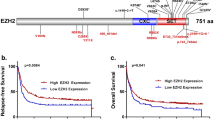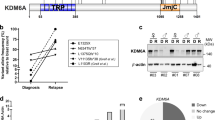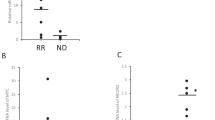Abstract
In acute myeloid leukemia (AML), therapy resistance frequently occurs, leading to high mortality among patients. However, the mechanisms that render leukemic cells drug resistant remain largely undefined. Here, we identified loss of the histone methyltransferase EZH2 and subsequent reduction of histone H3K27 trimethylation as a novel pathway of acquired resistance to tyrosine kinase inhibitors (TKIs) and cytotoxic drugs in AML. Low EZH2 protein levels correlated with poor prognosis in AML patients. Suppression of EZH2 protein expression induced chemoresistance of AML cell lines and primary cells in vitro and in vivo. Low EZH2 levels resulted in derepression of HOX genes, and knockdown of HOXB7 and HOXA9 in the resistant cells was sufficient to improve sensitivity to TKIs and cytotoxic drugs. The endogenous loss of EZH2 expression in resistant cells and primary blasts from a subset of relapsed AML patients resulted from enhanced CDK1-dependent phosphorylation of EZH2 at Thr487. This interaction was stabilized by heat shock protein 90 (HSP90) and followed by proteasomal degradation of EZH2 in drug-resistant cells. Accordingly, inhibitors of HSP90, CDK1 and the proteasome prevented EZH2 degradation, decreased HOX gene expression and restored drug sensitivity. Finally, patients with reduced EZH2 levels at progression to standard therapy responded to the combination of bortezomib and cytarabine, concomitant with the re-establishment of EZH2 expression and blast clearance. These data suggest restoration of EZH2 protein as a viable approach to overcome treatment resistance in this AML patient population.
This is a preview of subscription content, access via your institution
Access options
Subscribe to this journal
Receive 12 print issues and online access
$209.00 per year
only $17.42 per issue
Buy this article
- Purchase on Springer Link
- Instant access to full article PDF
Prices may be subject to local taxes which are calculated during checkout






Similar content being viewed by others
Accession codes
References
Roboz, G.J. Novel approaches to the treatment of acute myeloid leukemia. Hematology Am. Soc. Hematol. Educ. Program 2011, 43–50 (2011).
Schenk, T. et al. Inhibition of the LSD1 (KDM1A) demethylase reactivates the all-trans-retinoic acid differentiation pathway in acute myeloid leukemia. Nat. Med. 18, 605–611 (2012).
Krug, U., Büchner, T., Berdel, W.E. & Müller-Tidow, C. The treatment of elderly patients with acute myeloid leukemia. Dtsch. Arztebl. Int. 108, 863–870 (2011).
Knoechel, B. et al. An epigenetic mechanism of resistance to targeted therapy in T cell acute lymphoblastic leukemia. Nat. Genet. 46, 364–370 (2014).
Sharma, S.V. et al. A chromatin-mediated reversible drug-tolerant state in cancer cell subpopulations. Cell 141, 69–80 (2010).
Ribeiro, A.F. et al. Mutant DNMT3A: a marker of poor prognosis in acute myeloid leukemia. Blood 119, 5824–5831 (2012).
Chou, W.C. et al. TET2 mutation is an unfavorable prognostic factor in acute myeloid leukemia patients with intermediate-risk cytogenetics. Blood 118, 3803–3810 (2011).
Metzeler, K.H. et al. ASXL1 mutations identify a high-risk subgroup of older patients with primary cytogenetically normal AML within the ELN Favorable genetic category. Blood 118, 6920–6929 (2011).
Ernst, T. et al. Inactivating mutations of the histone methyltransferase gene EZH2 in myeloid disorders. Nat. Genet. 42, 722–726 (2010).
Shih, A.H., Abdel-Wahab, O., Patel, J.P. & Levine, R.L. The role of mutations in epigenetic regulators in myeloid malignancies. Nat. Rev. Cancer 12, 599–612 (2012).
Margueron, R. & Reinberg, D. The Polycomb complex PRC2 and its mark in life. Nature 469, 343–349 (2011).
O'Carroll, D. et al. The polycomb-group gene Ezh2 is required for early mouse development. Mol. Cell. Biol. 21, 4330–4336 (2001).
Nikoloski, G. et al. Somatic mutations of the histone methyltransferase gene EZH2 in myelodysplastic syndromes. Nat. Genet. 42, 665–667 (2010).
Guglielmelli, P. et al. EZH2 mutational status predicts poor survival in myelofibrosis. Blood 118, 5227–5234 (2011).
Sashida, G. et al. Ezh2 loss promotes development of myelodysplastic syndrome but attenuates its predisposition to leukaemic transformation. Nat. Commun. 5, 4177 (2014).
Varambally, S. et al. The polycomb group protein EZH2 is involved in progression of prostate cancer. Nature 419, 624–629 (2002).
Zingg, D. et al. The epigenetic modifier EZH2 controls melanoma growth and metastasis through silencing of distinct tumour suppressors. Nat. Commun. 6, 6051 (2015).
Bitler, B.G. et al. Synthetic lethality by targeting EZH2 methyltransferase activity in ARID1A-mutated cancers. Nat. Med. 21, 231–238 (2015).
Morin, R.D. et al. Somatic mutations altering EZH2 (Tyr641) in follicular and diffuse large B-cell lymphomas of germinal-center origin. Nat. Genet. 42, 181–185 (2010).
Grimwade, D. et al. Refinement of cytogenetic classification in acute myeloid leukemia: determination of prognostic significance of rare recurring chromosomal abnormalities among 5876 younger adult patients treated in the United Kingdom Medical Research Council trials. Blood 116, 354–365 (2010).
Abdel-Wahab, O. et al. ASXL1 mutations promote myeloid transformation through loss of PRC2-mediated gene repression. Cancer Cell 22, 180–193 (2012).
Fiskus, W. et al. Combined epigenetic therapy with the histone methyltransferase EZH2 inhibitor 3-deazaneplanocin A and the histone deacetylase inhibitor panobinostat against human AML cells. Blood 114, 2733–2743 (2009).
Stölzel, F. et al. Mechanisms of resistance against PKC412 in resistant FLT3-ITD positive human acute myeloid leukemia cells. Ann. Hematol. 89, 653–662 (2010).
Heidel, F. et al. Clinical resistance to the kinase inhibitor PKC412 in acute myeloid leukemia by mutation of Asn-676 in the FLT3 tyrosine kinase domain. Blood 107, 293–300 (2006).
Bunz, F. et al. Disruption of p53 in human cancer cells alters the responses to therapeutic agents. J. Clin. Invest. 104, 263–269 (1999).
Subramanian, A. et al. Gene set enrichment analysis: a knowledge-based approach for interpreting genome-wide expression profiles. Proc. Natl. Acad. Sci. USA 102, 15545–15550 (2005).
Sauvageau, G. et al. Differential expression of homeobox genes in functionally distinct CD34+ subpopulations of human bone marrow cells. Proc. Natl. Acad. Sci. USA 91, 12223–12227 (1994).
Armstrong, S.A., Golub, T.R. & Korsmeyer, S.J. MLL-rearranged leukemias: insights from gene expression profiling. Semin. Hematol. 40, 268–273 (2003).
Hanson, R.D. et al. Mammalian Trithorax and polycomb-group homologues are antagonistic regulators of homeotic development. Proc. Natl. Acad. Sci. USA 96, 14372–14377 (1999).
Klein, H.U. et al. Integrative analysis of histone ChIP-seq and transcription data using Bayesian mixture models. Bioinformatics 30, 1154–1162 (2014).
Cancer Genome Atlas Research Network. Genomic and epigenomic landscapes of adult de novo acute myeloid leukemia. N. Engl. J. Med. 368, 2059–2074 (2013).
Wu, S.C. & Zhang, Y. Cyclin-dependent kinase 1 (CDK1)-mediated phosphorylation of enhancer of zeste 2 (Ezh2) regulates its stability. J. Biol. Chem. 286, 28511–28519 (2011).
Wei, Y. et al. CDK1-dependent phosphorylation of EZH2 suppresses methylation of H3K27 and promotes osteogenic differentiation of human mesenchymal stem cells. Nat. Cell Biol. 13, 87–94 (2011).
Chen, S. & Smith, D.F. Hop as an adaptor in the heat shock protein 70 (Hsp70) and hsp90 chaperone machinery. J. Biol. Chem. 273, 35194–35200 (1998).
Caldas-Lopes, E. et al. Hsp90 inhibitor PU-H71, a multimodal inhibitor of malignancy, induces complete responses in triple-negative breast cancer models. Proc. Natl. Acad. Sci. USA 106, 8368–8373 (2009).
Weissman, A.M. Themes and variations on ubiquitylation. Nat. Rev. Mol. Cell Biol. 2, 169–178 (2001).
Pabst, C. et al. GPR56 identifies primary human acute myeloid leukemia cells with high repopulating potential in vivo. Blood 127, 2018–2027 (2016).
Khan, S.N. et al. Multiple mechanisms deregulate EZH2 and histone H3 lysine 27 epigenetic changes in myeloid malignancies. Leukemia 27, 1301–1309 (2013).
Lindsley, R.C. et al. Acute myeloid leukemia ontogeny is defined by distinct somatic mutations. Blood 125, 1367–1376 (2015).
Döhner, H. et al. Diagnosis and management of acute myeloid leukemia in adults: recommendations from an international expert panel, on behalf of the European LeukemiaNet. Blood 115, 453–474 (2010).
Makishima, H. et al. Mutations in the spliceosome machinery, a novel and ubiquitous pathway in leukemogenesis. Blood 119, 3203–3210 (2012).
Zhang, S.J. et al. Genetic analysis of patients with leukemic transformation of myeloproliferative neoplasms shows recurrent SRSF2 mutations that are associated with adverse outcome. Blood 119, 4480–4485 (2012).
Attar, E.C. et al. Bortezomib added to daunorubicin and cytarabine during induction therapy and to intermediate-dose cytarabine for consolidation in patients with previously untreated acute myeloid leukemia age 60 to 75 years: CALGB (Alliance) study 10502. J. Clin. Oncol. 31, 923–929 (2013).
Faber, J. et al. HOXA9 is required for survival in human MLL-rearranged acute leukemias. Blood 113, 2375–2385 (2009).
Pabst, C. et al. Identification of small molecules that support human leukemia stem cell activity ex vivo. Nat. Methods 11, 436–442 (2014).
Kim, W. et al. Targeted disruption of the EZH2-EED complex inhibits EZH2-dependent cancer. Nat. Chem. Biol. 9, 643–650 (2013).
Atanassov, I. & Urlaub, H. Increased proteome coverage by combining PAGE and peptide isoelectric focusing: comparative study of gel-based separation approaches. Proteomics 13, 2947–2955 (2013).
Cox, J. & Mann, M. MaxQuant enables high peptide identification rates, individualized p.p.b.-range mass accuracies and proteome-wide protein quantification. Nat. Biotechnol. 26, 1367–1372 (2008).
Cox, J. et al. Andromeda: a peptide search engine integrated into the MaxQuant environment. J. Proteome Res. 10, 1794–1805 (2011).
Shevchenko, A., Tomas, H., Havlis, J., Olsen, J.V. & Mann, M. In-gel digestion for mass spectrometric characterization of proteins and proteomes. Nat. Protoc. 1, 2856–2860 (2006).
Oellerich, T. et al. FLT3-ITD and TLR9 use Bruton tyrosine kinase to activate distinct transcriptional programs mediating AML cell survival and proliferation. Blood 125, 1936–1947 (2015).
Hömme, C. et al. Low SMC1A protein expression predicts poor survival in acute myeloid leukemia. Oncol. Rep. 24, 47–56 (2010).
Remmele, W. & Stegner, H.E. [Recommendation for uniform definition of an immunoreactive score (IRS) for immunohistochemical estrogen receptor detection (ER-ICA) in breast cancer tissue]. Pathologe 8, 138–140 (1987).
Vick, B. et al. An advanced preclinical mouse model for acute myeloid leukemia using patients' cells of various genetic subgroups and in vivo bioluminescence imaging. PLoS One 10, e0120925 (2015).
Li, H. & Durbin, R. Fast and accurate short read alignment with Burrows-Wheeler transform. Bioinformatics 25, 1754–1760 (2009).
Ye, K., Schulz, M.H., Long, Q., Apweiler, R. & Ning, Z. Pindel: a pattern growth approach to detect break points of large deletions and medium sized insertions from paired-end short reads. Bioinformatics 25, 2865–2871 (2009).
Meissner, A. et al. Genome-scale DNA methylation maps of pluripotent and differentiated cells. Nature 454, 766–770 (2008).
Schoofs, T. et al. DNA methylation changes are a late event in acute promyelocytic leukemia and coincide with loss of transcription factor binding. Blood 121, 178–187 (2013).
Dietrich, N. et al. REST-mediated recruitment of polycomb repressor complexes in mammalian cells. PLoS Genet. 8, e1002494 (2012).
Lerdrup, M., Johansen, J.V., Agrawal-Singh, S. & Hansen, K. An interactive environment for agile analysis and visualization of ChIP-sequencing data. Nat. Struct. Mol. Biol. 23, 349–357 (2016).
Acknowledgements
We are grateful to J.H. Song and T.S. Kim (Korea University, Seoul, Republic of Korea) and to S. Chouaib (INSERM U1186, Gustave Roussy Cancer Campus, Villejuif, France) for providing cell lines. The authors thank D. Wendt-Cousin and A. Küttner for excellent technical assistance, and K. Agelopoulos and I. Schulze for assistance with exome library preparation and processing. We are grateful to the University of Münster core facilities IFG/IZKF for performing the Affymetrix gene expression arrays and the LIFA for Illumina sequencing of Exome libraries. We thank atelier42 for designing the graphical model of chemoresistance. S.G. and C.M.-T. hold the copyright for the graphic art. The Münster laboratory of W.E.B. was supported by the Deutsche Forschungsgemeinschaft, DFG EXC 1003 Cells in Motion–Cluster of Excellence. This work was further supported by grants from the Deutsche Forschungsgemeinschaft (SPP1463, MU1328/9-2 to C.M.-T.), the German Cancer Aid Foundation (111286 to C.M.-T.), the German José-Carreras Leukemia Foundation (DJCLS R 13/04 to C.M.-T.) and the state of Sachsen-Anhalt (FZK 28/43 to C.M.-T.).
Author information
Authors and Affiliations
Contributions
S.G., S.A.-S. and T. Schenk performed cell culture experiments, ChIP-seq, quantitative PCR, RNAi, western blotting, immunoprecipitations and flow cytometry; T. Sauer, S.T., G.K. and C.W. performed tissue microarray production, staining and analysis. F.S., G.E. and C.T. performed EZH2 mRNA expression analysis of AML patients and established the MV4-11R cell line. C.T., W.E.B., A.Z., L.P.M. and K.S. provided patient samples. H.-U.K., M.D., S.A.-S., K.H., C.R. and M.L. performed bioinformatic analysis of mRNA expression microarrays, ChIP-Seq and Exome-Seq data. T.O., H.S., K.-T.P. and H.U. performed and analyzed label free and SILAC-labeled mass spectrometry of EZH2. C.T. and S.H. performed diagnostic sequencing of primary AML samples. S.G., C.P., B.V. and I.J. performed and analyzed mouse experiments. All authors discussed the results and commented on the manuscript. S.G. and C.M.-T. designed the study, analyzed the data and wrote the paper. T.O. and S.A.-S. share second authorship of this paper.
Corresponding authors
Ethics declarations
Competing interests
The authors declare no competing financial interests.
Supplementary information
Supplementary Figures and Tables
Supplementary Figures 1–8, Supplementary Tables 1, 2, 5, 7, and 16 (PDF 18566 kb)
Supplementary Table 3
Mutations in matched diagnosis and relapse samples (XLSX 13 kb)
Supplementary Table 4
Clinical and cytogenetics data of patient samples used for in vitro DZNep treatments. (XLSX 10 kb)
Supplementary Table 6
Target genes determined by integrated analysis of gene expression and ChIP-seq (XLSX 13 kb)
Supplementary Table 8
Data sets and statistics of SILAC (pT487-EZH2) immunoprecipitation quantitative proteomics in MV4-11R EV cells (XLSX 56 kb)
Supplementary Table 9
Data sets and statistics of SILAC (EZH2) immunoprecipitation quantitative proteomics in MV4-11R EV cells (XLSX 88 kb)
Supplementary Table 10
Data sets and statistics of SILAC (pT487-EZH2) immunoprecipitation quantitative proteomics in MV4-11R T487A cells (XLSX 85 kb)
Supplementary Table 11
Data sets and statistics of SILAC (EZH2) immunoprecipitation quantitative proteomics in MV4-11R T487A cells (XLSX 45 kb)
Supplementary Table 12
Data sets and statistics of SILAC (EZH2) immunoprecipitation quantitative proteomics in MV4-11 cells (XLSX 75 kb)
Supplementary Table 13
Data sets and statistics of SILAC (EZH2) immunoprecipitation quantitative proteomics in MV4-11R cells (XLSX 77 kb)
Supplementary Table 14
Data sets and statistics of SILAC (EZH2) immunoprecipitation quantitative proteomics in MV4-11R cells + carfilzomib (XLSX 45 kb)
Supplementary Table 15
Clinical and cytogenetics data of patient samples used for in vitro bortezomib treatment studies (XLSX 10 kb)
Rights and permissions
About this article
Cite this article
Göllner, S., Oellerich, T., Agrawal-Singh, S. et al. Loss of the histone methyltransferase EZH2 induces resistance to multiple drugs in acute myeloid leukemia. Nat Med 23, 69–78 (2017). https://doi.org/10.1038/nm.4247
Received:
Accepted:
Published:
Issue Date:
DOI: https://doi.org/10.1038/nm.4247
This article is cited by
-
FLT3 tyrosine kinase inhibition modulates PRC2 and promotes differentiation in acute myeloid leukemia
Leukemia (2024)
-
Tumor-suppressive functions of protein lysine methyltransferases
Experimental & Molecular Medicine (2023)
-
Mutations in the histone methyltransferase Ezh2 drive context-dependent leukemia in Xenopus tropicalis
Leukemia (2023)
-
SMYD3 regulates gastric cancer progression and macrophage polarization through EZH2 methylation
Cancer Gene Therapy (2023)
-
The roles of EZH2 in cancer and its inhibitors
Medical Oncology (2023)



